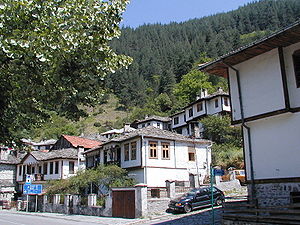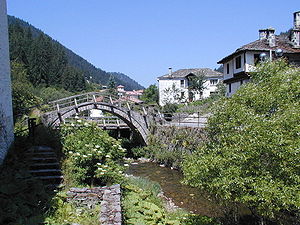
Shiroka Laka
Encyclopedia


Bulgaria
Bulgaria , officially the Republic of Bulgaria , is a parliamentary democracy within a unitary constitutional republic in Southeast Europe. The country borders Romania to the north, Serbia and Macedonia to the west, Greece and Turkey to the south, as well as the Black Sea to the east...
, located in Smolyan
Smolyan
Smolyan is a town and ski resort in the very south of Bulgaria not far from the border with Greece. It is the administrative and industrial centre of the homonymous Smolyan Province...
municipality, Smolyan Province
Smolyan Province
-Religion:The Smolyan province along with the Kardzhali Province is a province where the predominant religion is not Orthodox Christianity but Islam. However, unlike Kardzhali where the majority of the population is Turkish, the Muslim population of the Smolyan province is made up almost entirely...
. It is a proclaimed architectural and folklore reserve and lies in the central Rhodope Mountains
Rhodope Mountains
The Rhodopes are a mountain range in Southeastern Europe, with over 83% of its area in southern Bulgaria and the remainder in Greece. Its highest peak, Golyam Perelik , is the seventh highest Bulgarian mountain...
, 23 northwest of Smolyan, 16 km from Pamporovo
Pamporovo
Pamporovo is a popular ski resort in Smolyan Province, southern Bulgaria, one of the best-known in Southeastern Europe. It is set amongst magnificent pine forests and is primarily visited during the winter for skiing and snowboarding. It is also a popular tourist place in summer. The hub of...
and 22 southeast of Devin
Devin, Bulgaria
Devin is a town in Smolyan Province in the far south of Bulgaria. It is the administrative centre of the homonymous Devin Municipality. As of December 2009, the town has a population of 7,054 inhabitants.-Location and geography:...
.
The dominant and traditional religion in the village is Eastern Orthodox Christianity
Christianity
Christianity is a monotheistic religion based on the life and teachings of Jesus as presented in canonical gospels and other New Testament writings...
and the population is 573 . Shiroka Laka lies at 1,206 m above sea level, at 41°41′N 24°35′E. The mayor is Aleksandar Kavroshilov. The village has existed at this place since the 17th century and was founded by Bulgarians fleeing from the forcible Islamization
Islamization
Islamization or Islamification has been used to describe the process of a society's conversion to the religion of Islam...
conducted by the Ottoman
Ottoman Empire
The Ottoman EmpireIt was usually referred to as the "Ottoman Empire", the "Turkish Empire", the "Ottoman Caliphate" or more commonly "Turkey" by its contemporaries...
authorities of the time in the Rhodopes.
Architecture
Shiroka Laka is famous for its authentic Rhodopean houses set in tiers on both banks of the local river. The old houses were designed in the characteristic architectural style of the Rhodopes by the noted local building masters, and feature two storeys, orielOriel
An oriel window is a type of bay window which projects from a wall.Oriel may also refer to:Places in the United Kingdom:*Oriel College, Oxford*Oriel Street, Oxford*Oriel Square, Oxford*Oriel Chambers, LiverpoolPlaces in Ireland:...
s, built-in cupboards and a small cellar with a hiding place. The thick white walls hide the yard from the outsiders' eyes. The yard is small and slab-covered and has a typical stone drinking fountain in the middle. Some of the most famous houses are those of the Zgurov, Uchikov and Grigorov families.
The local Church of the Holy Mother of God was constructed in 1834 for 38 days according to the legend. It boasts an authentic iconostasis
Iconostasis
In Eastern Christianity an iconostasis is a wall of icons and religious paintings, separating the nave from the sanctuary in a church. Iconostasis also refers to a portable icon stand that can be placed anywhere within a church...
, possibly painted by apprentices of the brothers Dimitar
Dimitar Zograf
Dimitar Hristov , better known as Dimitar Zograf , was a noted 19th-century Bulgarian painter known for his icons....
and Zahari Zograf
Zahari Zograf
Zahariy Hristovich Dimitrov , better known as Zahari Zograf is arguably the most famous Bulgarian painter of the Bulgarian National Revival, noted for his church mural paintings and icons and often regarded as the founder of secular art in Bulgaria due to the introduction of everyday life...
from Samokov
Samokov
Samokov is a town in Sofia Province in the southwest of Bulgaria. It is situated in a kettle between the mountains Rila and Vitosha, 55 kilometres from the capital Sofia...
, or even by the brothers themselves. The old school, built in 1835, is located near the church. There is one more church in the village, the Church of St Nicholas.
Culture
Shiroka Laka is known not only for its old Bulgarian architecture, but also for its singing tradition and the kaba gaidaGaida
The gaida is a musical instrument, aerophone, using enclosed reeds fed from a constant reservoir of air in the form of a bag.The gaida, and its variations, is a traditional musical instrument for entire Europe, Northern Africa and the Middle East....
, a local type of bagpipe. Some of the most prominent singers of Rhodopean music stem from the village, and many of the local families are well familiar with the style. A secondary school for folklore songs and instruments was founded in 1972.
On the first Sunday of March, the village also hosts one of the best known kukeri
Kukeri
Kukeri is a traditional Bulgarian ritual to scare away evil spirits, with a costumed man performing the ritual. The costumes cover most of the body and include decorated wooden masks of animals and large bells attached to the belt...
(specific Bulgarian type of carnival) celebrations in the country, Pesponedelnik as it is called. On that day, people dressed as folklore monsters, carrying wooden swords and painted red, dance around the village to drive the evil spirits out of the homes and the peoples' souls. Their costumes are decorated with bulbs of garlic, beans and peppers and they wear a belt with characteristic Rhodope bells attached to it.

